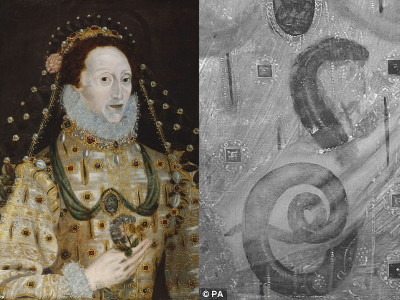``Bluetooth'' discovered in the bones of a 1000-year-old woman

A blue pigment called
Medieval women's early involvement in manuscript production suggested by lapis lazuli identification in dental calculus | Science Advances
http://advances.sciencemag.org/content/5/1/eaau7126
This Unknown Woman May Have Illustrated Elaborate and Sacred Medieval Manuscripts
https://www.livescience.com/64450-ultramarine-in-medieval-teeth.html
Ultramarine is a very expensive pigment made from the gemstone lapis lazuli . It is known that it was loved by many famous painters such as Michelangelo and Raphael , and it is said that Vermeer , who used ultramarine abundantly in his paintings, plunged his family into a quagmire of debt because of his heavy use of ultramarine.
The history of the world's most expensive color, a pigment more precious than gold, ``Ultramarine'' - GIGAZINE

Due to the preciousness of ultramarine, its use was limited to expensive pieces. The detection of ultramarine in women's dental plaque means that women helped create these expensive paintings and books. This is the first evidence of a connection between medieval women and ultramarines. Researchers say the discovery is evidence that women existed as accomplished writers even in the earliest days of medieval book publishing.
This woman was buried next to a monastery built between the 9th and 14th centuries, and radiocarbon dating revealed that she lived between 997 and 1162. He is believed to have died between the ages of 45 and 60, and judging from the burial site, it is assumed that he was a deeply religious person. In addition, an examination of the woman's bones revealed that she was in very good health, so it seems that she did not die from hard labor.

Blue particles were discovered in women's teeth in 2014, when another study was being conducted. A new research project was launched to further investigate blue teeth, and researchers crushed the plaque in samples to extract blue fragments. The blue particles observed under the microscope were taken from separate teeth near the lips and on the front, and more than 100 particles were stained a ``deep blue'' color. It is believed that plaque does not turn blue all at once, but from repeated actions such as holding a paintbrush in one's mouth.
Researchers also investigated the possibility that the blue

Of course, we cannot rule out the possibility that the women prepared the pigments for the painters and that the particles got on their teeth from the dust. Additionally, the custom of drinking lapis lazuli was common in the Mediterranean and Islamic countries, so it is possible that lapis lazuli was used for medicinal purposes, but this is unlikely as there was no such custom in Europe at the time. researchers see.
In Europe at the time, lapis lazuli was commonly used in

by Bench Accounting
Although it is generally believed that the holy books of the time were written by men living in monasteries, there is also evidence that they were written by educated women from aristocratic backgrounds living in monasteries. Few records of literature written by women in the early Middle Ages have been found, and the researchers believe this archaeological discovery shows that expensive pigments were used by religious women in Germany. states.
Related Posts:






